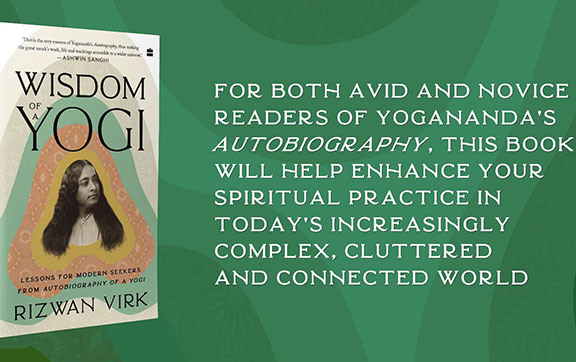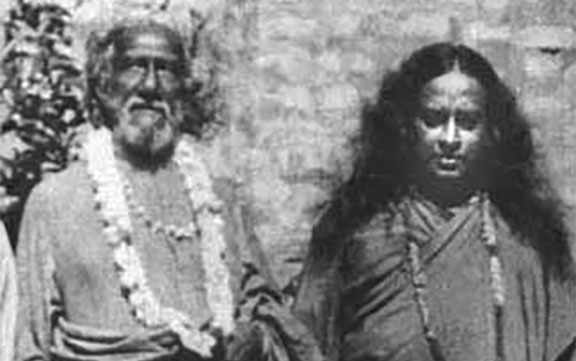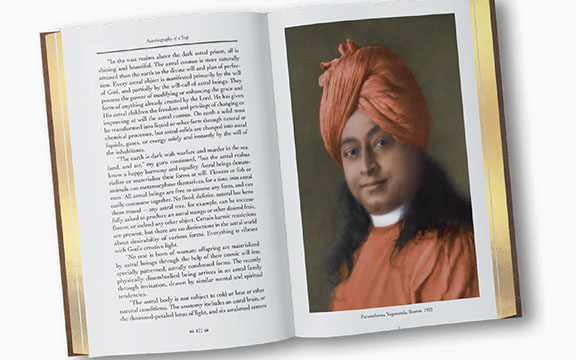
A new look at the wisdom of Paramahansa Yogananda through a modern lens.
The celebrated book, Autobiography of a Yogi, by Paramahansa Yogananda, is credited with changing the lives of tech genius Steve Jobs, musicians George Harrison and Elvis Presley, wellness guru Andrew Weill and actress Mariel Hemmingway, among many others. It also inspired Rizwan Virk to write Wisdom of a Yoga: Lessons for Modern Seekers from Autobiography of a Yogi. This new book, which was commissioned by Harper Collins India for the 75th anniversary of Autobiography of a Yogi, distills insights from Autobiography and includes wonderful quotes and teachings stories told by Paramahansa Yogananda. We’re pleased to include the following excerpt from Virk’s new book.
From science, then, if it must be let so, man learn the philosophic truth that there is no material universe; its warp and woof is maya, illusion. Its mirages of reality all break down under analysis. – Yogananda
Know all things to be like this: A mirage, a cloud castle, a dream, an apparition, without essence, but with qualities that can be seen. – Buddha, The Diamond Sutra
Throughout the centuries, mystics of all religions have effectively utilized very similar metaphors to convey the idea that the physical world around us is not the real world, and Yogananda was no different. Their goal in doing this is to try to detach us from our ‘over-attachment’ to the triumphs and tragedies that we experience on a daily basis. These metaphors compare physical reality to a dream, a stage play and, starting in the twentieth century, a film (via Yogananda).
I have tried to pick up the same thread in my recent books, using an updated metaphor that might seem like a departure from what the mystics of yore have said, but really isn’t. This is the metaphor of the world being like an interactive multiplayer video game, a computer simulation. Yogananda himself upgraded the metaphors of his predecessors by incorporating references to the latest twentieth-century technologies to make them appropriate and accessible for modern men and women. In this book, I’d like to do the same thing in the twenty-first century.
The World is a Dream
When we dream, we think that the dream-world is the real world. Think about the recent dreams you have had. Have you had a dream that involved less-than-ideal circumstances and woken up breathing a sigh of relief, thinking, ‘Wow, I’m glad that was just a dream!’? The dream metaphor is one that has been used for thousands of years. Yogananda himself used it to describe not only the illusory nature of the world but also the doors of entry into and out of this incarnation. “Birth and death are doors through which you pass from one dream to another.”
Many sects of Buddhism consider the dream metaphor central to their philosophical positioning. When a woman asked the erstwhile prince Siddhartha, shortly after his enlightenment, what he was, he used a term drawn from his native language, Pali: ‘Buddha.’ Though this is often translated today as ‘enlightened,’ the literal meaning of the word is ‘awakened,’ based on the Sanskrit root word ‘budh,’ which means ‘to be awake’ or ‘to become aware.’
Common sense tells us that if someone can ‘awaken,’ then they (and the rest of us) must be asleep. The metaphor of dreams has been a staple of the Buddhist worldview since the very beginning of the religion, including the Tibetan practice of dream yoga, one of the six yogas of Naropa.
Even the Quran hints at this idea that the physical world is only a distraction, a pastime, an amusement, and in various translations, a kind of game: “This life of the world is but a pastime and a game. Lo! the home of the Hereafter—that is Life, if they but knew.”
The Suffering of the World and Motion Pictures
Over years, many have used the metaphor of the stage play, including the Vedas, describing the world as the līla, or the play of the gods, and Shakespeare in his famous line the world’s a stage and the men and women merely players. In the twentieth century, our advanced understanding of light and motion made it possible to tell stories in a new, engrossing, realistic way: the art of motion pictures.
An illusion is defined as something that looks real but is not. The ideas of light and vision, of what we can and cannot see, are intrinsically linked to the concept of the illusion, particularly a carefully crafted illusion (maya) that is put on for us to lose ourselves in. Yogananda himself used this updated ‘modern’ metaphor of the physical world being like a motion picture. Unfortunately, this metaphor wasn’t available during Shakespeare’s era or in the time of the Vedas, or they might have used it too!

Photo: Swami Yogananda with his Guru, Sri Yukteswar.
The metaphor came to Yogananda through a rather disturbing and interesting vision. In 1915, shortly after being ordained ‘Swami Yogananda’ by his Guru, he had a peculiar but illuminating vision while meditating. That was a bloody year in Europe, with the Great War that had erupted the previous year still going strong. The scale of suffering caused by that war had never been seen before, partly because our technological capacity for destruction had reached new levels, with the advent of machine guns and automated artillery that could gun down many men in a short period of time.
In Yogananda’s engrossing vision, he was in the middle of a naval battle when his ship was blown up, and he jumped into the sea to save himself. He was then struck by a bullet in his chest and it seemed to him that he was in the process of dying. Suddenly, he found himself back in India, meditating in the middle of a room in Calcutta, in hysterical tears after his vision of the near-death experience. He wondered: Was he dead or alive?
A dazzling play of light filled the whole horizon. A soft rumbling vibration formed itself into words: “What has life or death to do with Light? In the image of My light I have made you. The relativities of life and death belong to the cosmic dream. Behold your dreamless being! Awake, my child, awake!” Later, he entered a cinema to see newsreels of World War I and, upon seeing the horrific devastation, asked, “Lord … why dost Thou permit such suffering?” The answer not only gave him a new way of looking at the world but also a new understanding of the concept of maya, which he had read about but now intuitively understood by seeing the actual European battlefields and the many dead.
“ ‘Look intently!’ A gentle voice spoke to my inner consciousness. ‘You will see that these scenes now being enacted in France are nothing but a play of chiaroscuro. They are the cosmic motion picture, as real and as unreal as the theater newsreel you have just seen, a play within a play.’ ” The voice in Yogananda’s vision went on to tell him: “Creation is light and shadow both, else no picture is possible.” The voice went on to make the point that, in a motion picture, pain and tragedy seem real, but that a man or woman no more dies than an actor who portrays death in a movie scene is actually dead. “Ceaseless joy,” Yogananda writes, “is not the state of this world.”
Yogananda and the Law of Miracles
This idea of the world being light is also the explanation Yogananda gives for the many miracles that he describes in his book. If the world is insubstantial and made of light, any miracle can be projected onto the screen of reality, and the script can be changed by someone who has mastered the knowledge of maya. This is how the masters can do things that seem incomprehensible to those of us who are readily caught up in the illusion: “The motion picture art can portray any miracle. From the impressive visual standpoint, no marvel is barred to trick photography. A man’s transparent astral body can be seen rising from his gross physical form, he can walk on the water, resurrect the dead, reverse the natural sequence of developments, and play havoc with time and space. Assembling the light images as he pleases, the photographer achieves optical wonders which a true master produces with actual light rays.”
Yogananda goes further and explains how the master’s powers of will and of visualization can project onto reality any phenomenon, raising questions about what constitutes a miracle if everything we see is illusion: “Through a master’s divine knowledge of light phenomena, he can instantly project into perceptible manifestation the ubiquitous light atoms. The actual form of the projection, whether it be a tree, a medicine, a human body, is in conformance with a yogi’s powers of will and of visualization.”
The Ultimate Metaphor: The World is Like a Video Game

Photo: Autobiography of a Yogi.
The dream, the stage play and the motion picture are useful metaphors, but none of them can serve as the ultimate metaphor for the nature of reality, because they lack one element that the masters tell us we have: the element of free will, the agency to change the script! I believe that if Yogananda or the rishis or even Shakespeare were alive today, they would use a more up-to-date metaphor while preserving the basic underlying concept of the world as maya. I can imagine what they might say, struggling with previous metaphors: The world is like a dream, but also like a motion picture, but also like a play, but one that is interactive, where the players, though they each come in with a script, have some agency to choose their actions and affect the outcome and re-write the script, and they can even become aware that they are in the middle of a play or dream or movie.
The metaphor that makes the most sense today is that of an interactive video game. In role-playing video games, like World of Warcraft or Fortnite or Roblox, we as players exist independently outside of the game. However, we descend or enter into the video game to play a specific character, with whom we identify, and then we are able to only perceive the world through the eyes of that character, which is coincidentally called an avatar. The word ‘avatar’ comes from an old Sanskrit root that means ‘to descend.’
In the same way that video games today are much more sophisticated than the video games of the 1980s like Pac Man and Space Invaders (classic games that I played as a kid); the ultimate video games will be able to convince us that we are in ‘reality’ when in fact we are in an illusory world. Everything that happens in this world would be, as Buddha suggests, “reflections on a very clear mirror, devoid of inherent existence.”
The interactive, multiplayer video game can be thought of as the latest, most accurate and most useful metaphor for the nature of our reality. This offers a better perspective on several issues: not just why there is suffering and why it’s important but also why we shouldn’t take it too seriously. It also provides explanations for how the magic and miracles Yogananda described in his Autobiography can be explained while satisfying the modern, scientific need to respect the rules of the physical world.
In a video game anything is possible, characters can float up, some can regenerate arms and legs, come back to life, show up in multiple places at once and objects can be rendered in front of our eyes out of nothingness. Keep this metaphor in mind as you face challenges and obstacles in the material world, which is inevitable. Changing perspective can help us deal with the most difficult situations in life. Think how the metaphor of the motion picture, and the realization that everything that is physical is actually made of light, changed Yogananda’s view of the world and suffering the world. Similarly, adopting the metaphor of the video game, consisting of a player (the real you) and a character (in the game) can change your perspective: “One’s values are profoundly changed when he is finally convinced that creation is only a vast motion picture, and that not in it, but beyond it, lies his own reality.”
And the next time anyone asks you about the nature of reality, ask them if they have ever played a video game!
[This excerpt from Wisdom of a Yogi: Lessons for Modern Seekers from Autobiography of a Yogi by Rizwan Virk has been published with permission from HarperCollins India.]
About the Author:
 Rizwan Virk is a successful entrepreneur and the founder of the startup accelerator Play Labs at MIT. A graduate of MIT and Stanford, he is currently a faculty associate at Arizona State University. He is also the author of Zen Entrepreneurship, Startup Myths, and Models: What You Won’t Learn in Business School, Treasure Hunt: Follow Your Inner Clues to Find True Success, and The Simulation Hypothesis: An MIT Computer Scientist Shows Why AI, Quantum Physics and Eastern Mystics Agree We Are in a Video Game.
Rizwan Virk is a successful entrepreneur and the founder of the startup accelerator Play Labs at MIT. A graduate of MIT and Stanford, he is currently a faculty associate at Arizona State University. He is also the author of Zen Entrepreneurship, Startup Myths, and Models: What You Won’t Learn in Business School, Treasure Hunt: Follow Your Inner Clues to Find True Success, and The Simulation Hypothesis: An MIT Computer Scientist Shows Why AI, Quantum Physics and Eastern Mystics Agree We Are in a Video Game.

